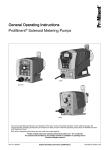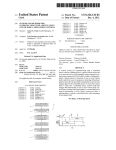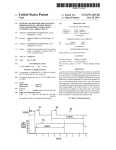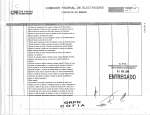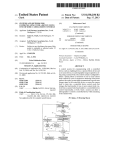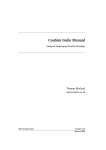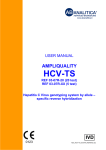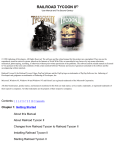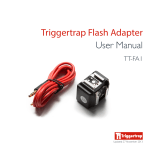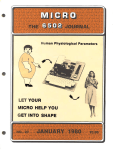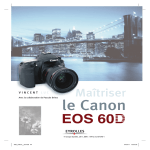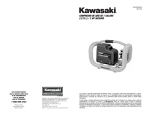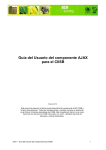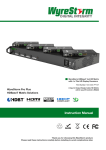Download Systems and methods for controlling a power state of a remote
Transcript
US008614766B1 (12) United States Patent (10) Patent N0.2 Clark (54) (45) Date Of Patent: SYSTEMS AND METHODS FOR 3,782,258 A CONTROLLING A POWER sTATE OF A 4,194,818 A BACKLIGHTING CONTROL SIGNALING Inventor: 4,201,434 A 5/1980 Tureck 4,209,244 A 6/1980 Sahara et al. - (Us) (Continued) (73) Assignee: Lab Partners Associates, Inc., South (*) galone er i11~ M980 Militiat' al James E. Clark, South Burlington, VT Burlington, VT (Us) Notice: Dec. 24, 2013 1/1974 Boekkooi et a1. 2 REMOTE DEVICE USING CAMERA BODY (75) US 8,614,766 B1 FOREIGN PATENT DOCUMENTS CA 2616030 l/20l3 CN 2007-80020420.4 6/2010 Subject to any disclaimer, the term of this patent is extended or adjusted under 35 C td ( on mue ) U.S.C. 154(b) by 200 days. OTHER PUBLICATIONS (21) Appl' No‘: 12/705,164 Affadavit of James E. Clark: Fl-ashWiZard II Synchronizer, signed Mar. 20, 2008; previously submitted 111 US. Appl. No. 11/697,241. (22) Filed: Feb. 12, 2010 (Continued) Related US. Application Data Primary Examiner * Anthony J Daniel; (60) I1’;o\éi3(i)o9nal application No. 61/151,885, ?led on Feb. (51) I t Cl 11 . 58 , A enl, or Firm * Birc (57) (200601) U 5 Cl U'SI;C ' F 1d "" "_ "" ( ) Ulsepco S Allorn Tree IP LaW & ABSTRACT . H04N 5022 (52) 74 (strgtegy PL?C g """ A control system for communicating With a Wirelessly ~remote 348/370 348/371 dev1ce, such as a l1ght1ng dev1ce, a special effects dev1ce and an in-scene device, in a photographic image-acquisition set ’ ting using a camera body. The control system is con?gured to "" " assl canon earc "" """""" ee app lcanon (56) """""" 3 4 8 /3 7 0 371 detect a camera body backlighting control signal. In response h, to detecting of the camera body backlighting control signal, e or Comp ete Seam ’ lstory' the control system generates a poWer state control signal for References Cited controlling the poWer state of the Wirelessly remote device. The control system then causes the poWer state control signal U.S. PATENT DOCUMENTS to be Wirelessly transmitted to the remote device so as to cause the remote device to operate in a ?rst poWer state. The control system also causes the remote device to change from 3,039,375 A 3,185,056 A 3,205,803 A 6/1962 Umbach 5/1965 Gold et a1. 9/1965 Burgarella et a1. the ?rst poWer state to a second poWer state. Such a system 3,259,042 A RE26,627 E 7/1966 Kagan 7/1969 Burgarella et a1. While remaining at the camera body. 3,659,509 A 5/1972 Burgarella 3,728,947 A 4/1973 Harnden et al. can alloW a photographer to easily control the remote device 26 Claims, 11 Drawing Sheets 100 105 110/‘ 115 DETECT A CAMERA BODY BACKLIGHTING CONTROL SIGNAL GENERATB A FIRST POWER STATE CONTROL SIGNAL 1N RESPONSE TO THE DETECTED SIGNAL WIRELESSLY 'l RANsMIT THE FIRST POWER STATE CONTROL SIGNAL so As To own ONE OR MORE DEVICES To OPERATE AT A FIRST POWER STATE ' CAUSE THE AT LEAST ONE I I REMOTE DEVICE TO CHANGE I 120 --- I FROM THE FIRST POWER sTATE I To A SECOND POWER STATE US 8,614,766 B1 Page 2 (56) References Cited U_S_ PATENT DOCUMENTS 7,880,761 B2 2/2011 Clark 7,885,533 B2 2/2011 Clark 7,965,335 B2 * 6/2011 7,969,504 B2 6/2011 Matsuda et al. 4,333,719 4,344,680 4,351,594 4,355,309 4,482,895 A A A A A 6/1982 8/1982 9/1982 10/1982 11/1984 Takamietal. Ishida et a1. Ishidaet a1. Hugheyetal. Weinberg 7,970,267 8,116,620 8,116,621 8,121,468 8,130,276 B1 B2 B2 B2 B2 6/2011 2/2012 2/2012 2/2012 3/2012 4,509,845 4,571,049 4,573,786 4,603,954 4,636,052 4,643,551 4,693,582 4,740,804 4,816,850 4,816,855 4,884,094 A A A A A A A A A A A 4/1985 2/1986 3/1986 8/1986 1/1987 2/1987 9/1987 4/1988 3/1989 3/1989 11/1989 Mizokami Tsunefujietal. Taniguchi et a1. Egawaetal. Bowsher Ohmori Kawamura et a1. Shands Phillipeaux etal. Kitauraetal. Kitauraetal. 8,134,576 8,180,210 8,326,136 8,326,140 8,326,141 8,331,776 B2 B2 B1 B2 B1 B2 8,351,774 8,526,808 8532476 8,538,250 8,559,804 B2 B2 B2 B2 B1 3/2012 5/2012 12/2012 12/2012 12/2012 12/2012 1/2013 9/2013 9/2013 9/2013 10/2013 4,988,584 A 5,016,037 A 5,159,375 5,283,610 5,299,012 5359375 5,384,611 5,422,543 5,436,531 5,521,708 5,640,623 5,692,223 5,708,833 5,713,050 5,721,971 5,734,934 A A A A A A A A A A A A A A 5,754,898 A 5,848,306 A 6,006,039 A 6,029,013 A 6,052,539 6,088,542 6,127,940 6,167,199 A A A A 6,188,431 131* 1/1991 Shaper 5/1991 Taniguchietal. 10/1992 2/l994 3/1994 10/1994 V1995 6/1995 7/1995 571996 6/1997 11/1997 1/1998 V1998 2/1998 3/1998 Taniguchi et a1‘ Sasaki TSuI-uta et a1‘ Clark Tsuji et a1‘ Weinberg Weinberg Beretta Sasaki Ichikawa et a1‘ Kinney et a1. OZaWa Sasaki Horinishietal. 5/1998 Nakano 12/1998 Shono 12/1999 Steinberg et a1‘ 2/2000 Larkin et a1‘ 4/2000 7/2000 10/2000 12/2000 2/2001 8,571,401 8,571,406 2001/0042149 2002/0009296 2002/0013161 2002/0067425 2002/0067923 2003/0128272 2003/0133018 2003/0161621 2003/0193588 2004/0036774 2005/0006484 2005/0174434 2006/0014563 2006/0216009 Niblock ...................... .. 348/371 Clark K1118 K1118 Clark Holmes Swanson etal. Clark Clark Clark Clark Clark Clark Clark Clark Clark Clark 10/2013 Clark 10/2013 Clark A1 A1 A1 A1 A1 A1 A1 A1 A1 A1 A1 A1 A1 A1 11/2001 1/2002 1/2002 6/2002 6/2002 7/2003 7/2003 8/2003 10/2003 2/2004 1/2005 8/2005 1/2006 9/2006 Ito et a1. Shaper et a1. Schaeffer et al. IVerson Fujimura Clough et a1. Ziernkowski Takaiwa Yuen et al. Nichols et al. Ito Chang et a1. Cheng Kawamum 2006/0275024 A1 2006/0291016 A1 2008/0065137 A1 12/2006 McNary 12/2006 Ishigamiet al. 3/2008 Boucher et al. 2008/0065139 A1 3/2008 Scribner et a1. Latorre Yanai et a1. Weinberg Fukui 2008/0180531 2009/0129765 2009/0135262 2009/0278479 A1 A1 A1 A1 Oie “““““““““““““ " 348/2115 2009/0310012 A1 7/2008 5/2009 5/2009 11/2009 Sekiguchi King Ogasawara Platner et a1. 12/2009 Ueda et al. 6,278,481 B1 8/2001 Schmidt 2010/0158494 A1 6/2010 King 6,351,610 B1 6,353,711 B1 6,366,737 B1 2/2002 Numako et a1‘ 3/2002 Numako et a1‘ 4/2002 Numako et a1. 2010/0177212 A1 2010/0202767 A1 2010/0209089 A1 7/2010 Holmes 8/2010 Shirakawa 8/2010 King 6,400,907 B1 6,404,987 B1 6/2002 IZukaWa 6/2002 Fukui 2011/0001665 A1 2011/0119409 A1 1/2011 King 5/2011 King 6,430,369 B2 6,453,154 B1 6,524,237 B1 8/2002 Lee et a1‘ 9/2002 Haber et a1. 2/2003 McGowan 2011/0123185 A1 loll/0128390 A1 2011/0129207 A1 5/2011 Clark 6/2011 Clark 6/2011 King et a1. 2011/0167008 2012/0027395 2012/0099847 2012/0120281 2012/0127340 2012/0127361 2012/0140088 2012/0148221 2012/0194699 2012/0207459 2012/0207460 2012/0243859 2013/0089313 2013/0094845 2013/0100340 7/2011 2/2012 4/2012 5/2012 5/2012 5/2012 6/2012 6/2012 8/2012 8/2012 8/2012 9/2012 4/2013 4/2013 4/2013 6,618,557 B1 6,625,399 B1 6,683,654 B1 6,718,135 6,731,952 6,748,165 6,778,764 6,798,986 6,941,067 7,016,603 7,035,534 7,133,607 7,134,658 7,362,965 7,437,063 7,446,800 B2 B2 B2 B2 B2 B2 B2 B2 B2 B2 B2 B2 B2 7,463,304 B2 7,684,692 B2 7,702,228 7,714,908 7,764,875 7,775,575 B2 B2 B2 B2 7,783,188 B2* 7,834,894 B2 7,877,005 B2* 9/2003 9/2003 V2004 4/2004 5/2004 6/2004 8/2004 9/2004 9/2005 3/2006 4/2006 11/2006 2/2007 4/2008 10/2008 11/2008 Ziemkowski Davis Haijima Kawasaki et a1‘ Schaefferetal. ogasawara Barghiniet a1‘ Hagiuda Muramatsu Clark Shih et a1‘ Clark squillace Clark Clark Holmes 12/2008 Mufréy 3/2010 Kashiyama 4/2010 5/2010 7/2010 8/2010 Clark Holmes Clark Clark 8/2010 Clark .......................... .. 396/198 11/2010 Swanson et a1. 1/2011 Okubo .......................... .. 396/56 A1 A1 A1 A1 A1 A1 A1 A1 A1 A1 A1 A1 A1 A1 A1 King Clark Clark Swanson et al. Holmes Clark Clark Clark Kouno Clark Clark Clark Clark Clark Clark FOREIGN PATENT DOCUMENTS CN CN EP EP 2010-10600736.4 2010-10600736.4 0984320 A1 077602639 2/2012 12/2012 3/2000 1/2011 EP 077602639 7/2011 EP 8756458.9 7/2011 EP 11177995.5 12/2011 US 8,614,766 B1 Page 3 (56) References Cited FOREIGN PATENT DOCUMENTS EP EP JP JP JP JP JP JP JP JP JP JP JP JP JP JP KR WO WO WO WO WO WO WO WO WO WO WO WO WO WO WO WO 111779955 11177997.1 56-143422 59-064821 59-170822 63-018874 05-093948 07-159866 2002-244193 2002-318413 2003-172970 2003-215672 2003-325451 2004-072230 2006-149935 2007-067870 10-0728117 9638925 PCT/US2003/37271 PCT/US2007/066162 PCT/US2006/028229 PCT/US2008/065137 PCT/US2008/065139 PCT/US2010/024088 2010093914 2010093927 2010093994 PCT/US2010/024108 PCT/US2010/024195 2012009537 PCT/US2011/044008 PCT/US2012/025915 2012161772 A A A A A A1 A1 A1 A1 A1 7/2012 12/2012 11/1981 4/1984 9/1984 1/1988 4/1993 6/1995 8/2002 10/2002 6/2003 7/2003 11/2003 3/2004 6/2006 3/2007 6/2007 12/1996 5/2004 11/2007 2/2008 9/2008 9/2008 7/2010 8/2010 8/2010 8/2010 9/2010 9/2010 1/2011 11/2011 6/2012 11/2012 PocketWiZard MultiMAX Transceiver Owner’s Manual, by LPA Design, May 2001, pp. 1-55 and “Relay Mode” on p. 40, United States. Quantum FreeWire Transceiver; Jul. 17, 2005; pp. 1 to 7; http://web. archive.org/web/20050717015832/http://www.qtm.com/wireless/ freewirehtml; last viewed at Internet Archive on Apr. 25, 2008. Quantum FreeWire Transceiver; Nov. 15, 2004; pp. 1 to 7; http://web. archive.org/web/20041115093657/http://www.qtm.com/wireless/ freewirehtml; last viewed at Internet Archive on Apr. 25, 2008. Quantum FreeWire Transceiver; Oct. 7, 2001; pp. 1 to 6; http://web. archive.org/web/20011007140624/http://www.qtm.com/wireless/ freewirehtml; last viewed at Internet Archive on Apr. 25, 2008. Rob Galbraith; Casting Light on the PocketWiZard MiniTTl and FlexTT5; Parts 1 to 5; Feb. 16, 2009; http://www.robgalbraith.com/ bins/multiipage.asp?cid:7-9884-9903; last viewed on Jul. 12, 2012. Robert Hanashiro; Equipment CorneriNews & Notes for all Those Gear-Heads; Nov. 26, 2001; pp. 1 to 3; http://www.sportsshooter. com/newsistory.html?id:594; last viewed on Septemer, 17, 2002. Strobist Blog: PocketWiZard FlexTT5 and MinITTl: Full Review; Feb. 16 to 18, 2009; blog comments, pp. 1 to 40; http://strobist. blogspot.com/2009/02/pocketwiZard-?extt5-and-minitt1-full.html; last viewed on Feb. 18, 2009. Strobist Blog: PocketWiZard FlexTT5 and MinITTl: Full Review Feb. 16, 2009; pp. 1 to 11; http://strobist.blogspot.com/2009/02/ pocketwiZard-?extt5-and-minitt1-full.html; last viewed on Feb. 18, 2009. US. Appl. No. 10/306,759, Aug. 29, 2003, Of?ce Action, 7,016,603. US. Appl. No. 10/306,759, Dec. 18, 2003, Response to Of?ce Action, 7,016,603. US. Appl. No. 10/306,759, Dec. 24, 2003, Examiner Interview Sum mary, 7,016,603. OTHER PUBLICATIONS US. Appl. No. 10/306,759, Mar. 27, 2004, Final Of?ce Action, 7,016,603. US. Appl. No. 10/306,759, Apr. 15, 2004, Examiner Interview Sum Analog Devices Technical Data Sheet for ADF7020-1 Transceiver mary, 7,016,603. US. Appl. No. 10/306,759, Apr. 20, 2004, Response to Final Of?ce A1 IC, Analog Devices, Inc., 2005, pp. 1-44. ASH Transceiver Impedance Matching; Document Created on Dec. 10, 2001; pp. 1 to 10; http://www.rfm.com/products/apnotes/anten namatch.pdf; last viewed on Dec. 15, 2005. Canon EOS 40D Usuer’s Manual; about Sep. 2007; Canon Corpo ration. Declaration ofJames E. Clark ?led on Feb. 18, 2005 in US . Appl. No. 10/ 306,759. Ken Rockwell; How to Use Nikon Strobes Wirelessly, for Free! ; Dec. 17, 2005; http://web.archive.org/web/20051217091704/http://www. kenrockwell.com/nikon/ittlslave.htm; last viewed at Internet archive on Apr. 1, 2010. Nikon D2x; Sep. 2004; pp. 1 to 12; Nikon Corporation. Nikon WT-l Transmitter User’s Manual; around Dec. 2003; Nikon Corporation. Action, 7,016,603. US. Appl. No. 10/306,759, Aug. 24, 2004, Of?ce Action, 7,016,603. US. Appl. No. 10/306,759, Feb. 18, 2005, Request for Continued Examination, 7,016,603. US. Appl. No. 10/306,759, Mar. 29, 2005, Of?ce Action, 7,016,603. U.S.Appl. No. 10/306,759,Apr. 14, 2005, Response to Of?ceAction, 7,016,603. US. Appl. No. 10/306,759, Jun. 29, 2005, Final Of?ce Action, 7,016,603. US. Appl. No. 10/306,759, Aug. 25, 2005, Response to Final Of?ce Action, 7,016,603. US. Appl. No. 10/306,759, Sep. 16, 2005, Notice of Allowance, 7,016,603. US. Appl. No. 10/306,759, Oct. 18, 2005, 312 Amendment, 7,016,603. US. Appl. No. 10/306,759, Dec. 20, 2005, Response to 312 Amend Nikon WT-2 Article, Part 1; Nikon Corporation; http://nikonimaging. ment, 7,016,603. com/global/technology/scene/1 1/Index.htm; last viewed on Mar. 14, 2008. Nikon WT-2 Article, Part 2: Nikon Corporation; http://nikonimaging. US. Appl. No. 10/306,759, Jan. 4, 2006, Response to 312 Amend com/global/technology/scene/11/Indexi02.htm; last viewed on Mar. 14, 2008. Phil Askey, Nikon D2H Review: 15. Wireless: Digital Photography Review, Wireless (Review of WT-l Transmitter); Dec. 2003; http:// www.dpreview.com/reviews/NikonD2H/page15.asp; last viewed on Mar. 18, 2008. Phil Askey, Nikon D2H Review: 1. Introduction: Digital Photogra phy Review, Nikon D2H Review, Dec. 2003; http://www.dpreview. com/reviews/NikonD2H/; last viewed on Mar. 18, 2008. Phil Askey, Nikon D2Hs Preview: 1. Introduction: Digital Photogra phy Review (includes Review of WT-2 Transmitter); Feb. 2005; http//www.dpreview.com/articles/nikond2hs/; last viewed Mar. 14, 2008. PocketWiZard MultiMAX Transceiver New Trigger Control Soft ware Features, by LPA Design, pp. 1 to 6, United States. ment, 7,016,603. US. Appl. No. 10/306,759, Nov. 18, 2006, Certi?cate ofCorrection, 7,016,603. US. Appl. No. 11/305,668, Mar. 8, 2006, Of?ce Action, 7,133,607. US. Appl. No. 11/305,668, Jun. 8, 2006, Response to Of?ce Action, 7,133,607. U.S.Appl. No. 11/305,668, Jun. 13, 2006, Supplemental Response to Request for Clari?cation by the Examiner, 7,133,607. US. Appl. No. 11/305,668, Jun. 30, 2006, Notice of Allowance, 7,133,607. US. Appl. No. 11/305,668, Mar. 29, 2007, Request for Correction of Letters Patent, 7,133,607. U.S.Appl. No. 11/529,203,Aug. 14, 2007, Of?ceAction, 7,362,965. US. Appl. No. 11/529,203, Oct. 16, 2007, Terminal Disclaimer, 7,362,965. US. Appl. No. 11/529,203, Oct. 16, 2007, Response to Of?ceAction, 7,362,965. US 8,614,766 B1 Page 4 (56) References Cited OTHER PUBLICATIONS U.S. Appl. No. 11/529,203, Oct. 25, 2007, Terminal Disclaimer, 7,362,965. US. Appl. No. 11/529,203, Dec. 14, 2007, Notice of Allowance, 7,362,965. US. Appl. No. 12/104,950, Dec. 31, 2009, Of?ce Action, 7,764,875. US. Appl. No. 12/104,950, Feb. 1, 2010, Response to Of?ce Action, 7,764,875. US. Appl. No. 12/104,950, Mar. 23, 2010, Notice of Allowance, 7,764,875. US. Appl. No. 12/843,254, Jul. 27, 2010, Preliminary Remarks, 8,121,468. US. Appl. No. 12/843,254, Aug. 25, 201 1, Of?ce Action, 8,121,468. US. Appl. No. 12/843,254, Aug. 25, 2011, Response to Of?ce Action, 8,121,468. US. Appl. No. 12/843,254, Aug. 25, 2011, Terminal Disclaimer, 8,121,468. US. Appl. No. 12/843,254, Nov. 28, 2011, Notice of Allowance, 8,121,468. US. Appl. No. 13/399,333, Jun. 14, 2012, Of?ce Action. U.S. Appl. No. 11/488/491, Oct. 16, 2007, Of?ce Action. U.S. Appl. No. 11/490,322, Apr. 20, 2010, Of?ce Action, 7,880,761. U.S.Appl. No. 11/490,322, Jul. 12, 2010, Response to Of?ceAction, 7,880,761. US. Appl. No. 11/490,322, Sep. 15, 2010, Notice of Allowance, 7,880,761. US. Appl. No. 11/697,241, Nov. 8, 2007, Of?ce Action, 7,437,063. US. Appl. No. 11/697,241, Mar. 10, 2008, Response to Of?ce Action, 7,437,063. US. Appl. No. 11/697,241, Mar. 24, 2008, Examiner Interview Sum mary, 7,437,063. US. Appl. No. 11/697,241, Jun. 9, 2008, Notice of Allowance, 7,437,063. US. Appl. No. 12/250,914, Jun. 12, 2009, Of?ce Action, 7,702,228. US. Appl. No. 12/250,914, Jun. 29, 2009, Response to Of?ce Action and Terminal Disclaimer, 7,702,228. US. Appl. No. 12/250,914, Oct. 28, 2009, Terminal Disclaimer, 7,702,228. US. Appl. No. 12/250,914, Dec. 3, 2009, Notice of Allowance, 7,702,228. US. Appl. No. 12/762,81 1, Dec. 28, 2010, Of?ce Action, 7,970,267. US. Appl. No. 12/762,811, Mar. 28, 2011, Response to Of?ce Action, 7,970,267. US. Appl. No. 12/762,811, Mar. 28, 2011, Terminal Disclaimer, 7,970,267. US. Appl. No. 12/762,811, Apr. 20, 2011, Notice of Allowance, 7,970,267. U.S.Appl.No. 13/169,413, Dec. 20, 2011, Of?ceAction, 8,180,210. U.S.Appl.No. 13/169,413, Jan. 16, 2012, Response to Of?ceAction, 8,180,210. US. Appl. No. 13/169,413, Jan. 16, 2012, Terminal Disclaimers, 8,180,210. US. Appl. No. 13/169,413, Mar. 22, 2012, Notice of Allowance, 8,180,210. US. Appl. No. 13/438,500, Jun. 18, 2012, Of?ce Action. U.S. Appl. No. 12/129,447, Apr. 12, 2010, Notice of Allowance, 7,775,575. US. Appl. No. 12/129,447, Apr. 12, 2010, Examiner Amendment, 7,775,575. US. Appl. No. 12/129,402, Apr. 19, 2010, Notice of Allowance, 7,783,188. US. Appl. No. 12/861,445, Sep. 30, 2010, Notice of Allowance, 7,885,533. US. Appl. No. 13/021,951, Nov. 25, 2011, Notice ofAllowance. U.S. Appl. No. 13/021,951, Feb. 13, 2012, Withdrawal of Notice of Allowance. U.S. Appl. No. 13/021,951,Feb. 22,2012, Of?ce Action. U.S. Appl. No. 13/253,596, Nov. 30, 2011, Of?ce Action. U.S. Appl. No. 13/253,596, Feb. 29, 2012, Response to Of?ceAction. U.S. Appl. No. 13/253,596, May 9, 2012, Final Of?ce Action. U.S. Appl. No. 12/705,052, Mar. 27, 2012, Of?ce Action. U.S. Appl. No. 12/705,052, Jun. 27, 2012, Response to Of?ceAction. U.S. Appl. No. 12/705,096, Mar. 12, 2012, Of?ce Action. U.S.Appl. No. 12/705,096, Jun. 12, 2012, Response to Of?ceAction. U.S. Appl. No. 12/705,164, Mar. 29, 2012, Of?ce Action. U.S. Appl. No. 12/705,164, Jun. 29, 2012, Response to Of?ceAction. U.S. Appl. No. 13/399,333, ?led Feb. 17, 2012. US. Appl. No. 13/016,345, ?led Jan. 28, 2011. US. Appl. No. 13/438,500, ?led Apr. 3, 2012. US. Appl. No. 13/021,951, ?led Feb. 7,2011. U.S. Appl. No. 13/253,596, ?led Oct. 5, 2011. US. Appl. No. 13/201,182, ?led Aug. 11,2011. U.S.Appl.No. 13/201,185,?ledAug. 11,2011. U.S. Appl. No. U.S. Appl. No. U.S. Appl. No. U.S. Appl. No. US. Appl. No. U.S. Appl. No. U.S. Appl. No. 13/201,281, ?led Aug. 12,2011. 13/208,686, ?led Aug. 12,2011. 13/208,706, ?led Aug. 12,2011. 13/401,175, ?led Feb. 21, 2012. 12/705,052, ?led Feb. 12,2010. 12/705,096, ?led Feb. 12,2010. 12/705,164, ?led Feb. 12,2010. XE-200 RF Shutter Release for Rebel 2000; http:// Zenopuseelectronix.com/XE-200.htrnl; last viewed on Sep. 9, 2002. US. Appl. No. 12/705,096, Aug. 8, 2012, Notice of Allowance, 8,326,136. US. Appl. No. 12/705,052, Sep. 5, 2012, Notice of Allowance, 8,326,141. U.S.Appl.No.13/399,333,Sep. 14, 2012, Response to Of?ceAction, 8,351,774. US. Appl. No. 13/399,333, Sep. 14, 2012, Terminal Disclaimers, 8,351,774. U.S.Appl.No.13/438,500,Sep. 14, 2012, Response to Of?ceAction. U.S. Appl. No. 13/438,500, Sep. 14, 2012, Terminal Disclaimers. U.S. Appl. No. 13/399,333, Sep. 28, 2012, Notice of Allowance, 8,351,774. US. Appl. No. 12/705,164, Nov. 29, 2012, RCE. U.S. Appl. No. 13/208,706, Dec. 26, 2012, Of?ce Action. U.S. Appl. No. 13/208,686, Feb. 6, 2013, Of?ce Action. U.S. Appl. No. 13/183,046, Feb. 13, 2013, Of?ce Action. U.S. Appl. No. 13/708,326, ?led Dec. 7, 2012. US. Appl. No. 13/692,515, ?led Dec. 3, 2012. US. Appl. No. 13/692,550, ?led Dec. 3, 2012. US. Appl. No. 13/735,325, ?led Jan. 7, 2013. Nikon D80 User’s Manual; see “Modeling Flash,” p. 98; published on Aug. 11, 2006. US. Appl. No. 13/735,325, Mar. 15, 2013, Of?ce Action. U.S. Appl. No. 13/735,325, Mar. 21, 2013, Response to Of?ce Action w/ Terminal Disclaimers. U.S. Appl. No. 13/708,326, Mar. 26, 2013, Notice ofAllowance. U.S. Appl. No. 13/208,706, Mar. 26, 2013, Response to Of?ce Action. U.S. Appl. No. 13/016,345, Apr. 26, 2013, Restriction Requirement. U.S. Appl. No. 13/183,046, Apr. 29, 2013, Response to Of?ceAction. U.S. Appl. No. 13/401,175, May 6, 2013, Of?ce Action. U.S. Appl. No. 13/208,686, May 6, 2013, Response to Of?ce Action. U.S. Appl. No. 13/735,325, May 14, 2013, Notice ofAllowance. U.S. Appl. No. 13/692,550, May 16, 2013, Notice ofAllowance. U.S. Appl. No. 13/201,182, May 24, 2013, Restriction Requirement. U.S. Appl. No. 13/438,500, Jun. 12, 2013, Notice ofAllowance. U.S. Appl. No. 13/692,515, Jun. 24, 2013, Notice ofAllowance. U.S. Appl. No. 13/208,706, Jul. 2, 2013, Notice ofAllowance. U.S. Appl. No. 13/692,550, Jul. 2, 2013, Supplemental Notice of Allowance. U.S. Appl. No. 13/208,686, Jul. 15, 2013, Final Of?ce Action. U.S. Appl. No. 13/183,046, Jul. 31, 2013, Notice ofAllowance. U.S. Appl. No. 13/401,175, DatedAug. 6, 2013, Response to Of?ce Action. U.S. Appl. No. 13/016,345, Dated Sep. 17,2013, Of?ce Action. U.S. Appl. No. 13/401,175, Dated Sep. 20, 2013, Notice ofAllow ance. U.S. Appl. No. 13/201,281, Dated Sep. 25, 2013, Of?ce Action. U.S. Appl. No. 13/208,686, Dated Sep. 30, 2013, Notice ofAllow ance. US 8,614,766 B1 Page 5 (56) References Cited U.S.App1.N0. 14/201,200, ?led Sep. 9, 2013. US. Appl. No. 14/015,336, ?led Aug. 30, 2013. OTHER PUBLICATIONS U.S. Appl. No. 14/021,200, Dated Oct. 8, 2013, Of?ce Action. * Cited by examiner US. Patent Dec. 24, 2013 Sheet 1 0f 11 US 8,614,766 B1 100 105 f DETECT A CAMERA BODY BACKLIGHTING CONTROL SIGNAL GENERATE A FIRST POWER STATE f CONTROL SIGNAL IN RESPONSE 110 TO THE DETECTED SIGNAL W WIRELES SLY TRANSMIT THE f FIRST POWER STATE CONTROL 115 SIGNAL SO AS TO CAUSE ONE OR MORE DEVICES TO OPERATE AT A FIRST POWER STATE l , 120 1 REMOTE DEVICE TO CHANGE E : FROM THE FIRST POWER STATE: } TO A SECOND POWER STATE ; US. Patent Dec. 24, 2013 Sheet 2 0f 11 FIG. 2 US 8,614,766 B1 US. Patent Dec. 24, 2013 Sheet 3 0f 11 US 8,614,766 B1 wmsss comm-BER Mm ENE'1 w,‘ABLE W W . W , x - ‘,1> . g ETERNAL. 430M111 1:; A?’ mm; 311; I . MEMORYB-ilé Li n 3m 1/ cmwmrmmww WM, mmamczasoa g / m,‘ . TRANWITTER ' ‘ | ii.“ 324 US. Patent Dec. 24, 2013 Sheet 4 0f 11 US 8,614,766 B1 [416 hiainftuancc Chmmals J Mocks L Help (1011110111211 Device Contra} S??'illgi “ ‘VI-11E - 432B - 4363 xx, 1st cimnge level 65%. 2nd change 1evg1__1_i}% 44GB Delay =_5 seconds , - \‘xl . 43mg‘? W44QA K . X \ - ‘X AP AS515’! - 1st change. level 100%, 2nd. change [121E526 Delay= 2 seconds Backlight- WC \ 448A ,mQKJIEI Bacldight ON - Device 01K 44MB JG Blacidight UN -~ BEViC'?‘ UFF 2.11 1 US. Patent Dec. 24, 2013 Sheet 5 0f 11 US 8,614,766 B1 505 START 500 YV 520 YES 5 l0 AF A MODE ENABLED ? NO GENERATE AND TRANSMIT IOC “V SIGNAL WITH FIRST SET ILLUMINATION VALUE 530 \ [IMPLEMENT SET DELAYI 535 -\ v CAUSE MODELING LIGHT TO CHANGE TO SECOND SET ILLUMINATION VALUE ' B/L MODE ENABLED A 585 1 V V 590 ( GENERATE AND TRANSMIT GENERATE AND TRANSMIT POWER POWER CHANGE SIGNAL (WITH FIRST SET POWER VALUE) CHANGE SIGNAL (WITH SECOND SET POWER VALUE) FIG. 5A US. Patent Dec. 24, 2013 Sheet 6 6f 11 US 8,614,766 B1 500 550 IOC SIGNAL @ A YES K 565 A | IMPLEMENT sET DELAYI 570 K GENERATE AND TRANSMIT \ 10c SIGNAL WITH FIRST SET POWER VALUE CAUSE REMOTE DEVICE TO CHANGE TO SECOND SET POWER VALUE FIG. 5B US. Patent Dec. 24, 2013 I f US 8,614,766 B1 Sheet 7 0f 11 604 [M 6433 VOLTAGE f mm as‘ DELAY LIGHT 100» 3Q / 5y 3 DELAY 28 [I we 704 VOLTAGE Q“ ‘ 5 5 AFA DELAY )145 . 2. s; DELAY.‘ mo HGHT gQ_ OUTPUT (2mm; 1Q 4O_ 2!) li 0 [I 1 .l Hi I 3 l14. -1 .41. I ! 6 US. Patent Dec. 24, 2013 Sheet 9 0f 11 US 8,614,766 B1 "5' Alt. Device Alt. Device " Extent 972(N) FIG. 9 900 US. Patent Dec. 24, 2013 $2 Sheet 10 0f 11 US 8,614,766 B1 $2 US. Patent Dec. 24, 2013 Sheet 11 0f 11 as: :1. .._ i. :El Kg: US 8,614,766 B1 US 8,614,766 B1 1 2 SYSTEMS AND METHODS FOR CONTROLLINGA POWER STATE OF A REMOTE DEVICE USING CAMERA BODY BACKLIGHTING CONTROL SIGNALING the studio and/or readying the scene for image acquisition. Usually, a photographer or photographer’ s assistant manually controls the pertinent ambient lighting device(s) using con ventional dedicated controls. RELATED APPLICATION DATA SUMMARY OF THE DISCLOSURE This application claims the bene?t of priority of US. Pro visional Patent Application No. 61/151,885, ?led on Feb. 12, 2009, and titled “Systems And Methods For Controlling A PoWer State Of A Remote Device Using Camera Body Back a method of controlling a poWer state of a remote device using a camera body. The method includes: detecting a ?rst camera In one implementation, the present disclosure is directed to body backlighting control signal; generating a ?rst poWer state control signal in response to the detecting of the ?rst camera body backlighting control signal, Wherein the ?rst poWer state control signal is con?gured to change the poWer state of the remote device; and Wireles sly transmitting the ?rst lighting Control,” Which is incorporated here in by reference in its entirety. FIELD OF THE INVENTION poWer state control signal to the remote device in response to the detecting of the ?rst camera body backlighting control The present invention generally relates to the ?eld of pho tography. In particular, the present invention is directed to signal so as to cause the remote device to operate at a ?rst poWer state. systems and method for controlling a poWer state of a remote device using camera body backlighting control. 20 BACKGROUND Photography is an integral component of modern society, and photographed images pervade our lives. Photographic of a remote device using a camera body. The machine-execut able instructions include: a ?rst set of machine-executable 25 images appear, for example, in books, magaZines, catalogs, journals, neWspapers, billboards, posters and scrapbooks and are displayed in homes, art galleries, retail stores, shopping malls, of?ce buildings and many other places. While many photographic images are acquired using only natural ambient light, many other images are acquired using photographic ?ash lighting. When image-acquisition ?ash lighting is used, 30 instructions for implementing detection of a ?rst camera body backlighting control signal; a second set of machine-execut able instructions for generating a ?rst poWer state control signal in response to the detection of the ?rst camera body backlighting control signal, Wherein the ?rst poWer state con trol signal is con?gured to change the poWer state of the remote device; and a third set of machine executable instruc tions for controlling Wireless transmission of the ?rst poWer a photographer often uses one or more modeling lights prior to image acquisition for any of a variety of reasons, such as checking for unWanted shadoWs, glare, re?ection, etc. and/or checking for desired shadoWs and other lighting effects. Gen In another implementation, the present disclosure is directed to a machine-readable storage medium containing machine-executable instructions for controlling a poWer state state control signal to the remote device in response to the detecting of the ?rst camera body backlighting control signal 35 so as to cause the remote device to operate at a ?rst poWer state. erally, these modeling lights are either kept poWered up to a BRIEF DESCRIPTION OF THE DRAWINGS suf?cient level or turned up to a su?icient level When needed. Keeping the modeling lighting poWered up can be problem atic due to the heat this type of lighting generates, Which can be uncomfortable for live models and detrimental to heat 40 sensitive still subjects. Occasionally turning up the poWer of HoWever, it should be understood that the present invention is not limited to the precise arrangements and instrumentalities shoWn in the draWings, Wherein: modeling lighting can be inconvenient, even using more recent remotely-controlled modeling lights. Many photographic images are acquired Without adding For the purpose of illustrating the invention, the draWings shoW aspects of one or more embodiments of the invention. 45 For the purpose of illustrating the invention, the draWings special effects to the captured scene. HoWever, many other shoW aspects of one or more embodiments of the invention. photographic images are acquired using added special HoWever, it should be understood that the present invention is not limited to the precise arrangements and instrumentalities shoWn in the draWings, Wherein: FIG. 1 is a ?oW diagram illustrating a method of controlling effects, such as arti?cial Wind, snoW, mist and rain, and/or using contrived scenes that use in-scene props and other items, such as in-scene lighting. Today, many special effects generators, for example, fans, snoW shakers, mi sters and rain 50 the scene illumination output of one or more modeling lights using a camera body; FIG. 2 is a diagram of a photographic system that includes systems, are turned off and on electronically using dedicated on/off and/or speed/poWer control sWitches. Similarly, in scene lighting can often be controlled using such dedicated control sWitches. Typically, a photographer, or more often a a camera, a Wireless controller, a remote multifunctional 55 photographer’s assistant, has the task of controlling the operation of any special effects devices and in-scene lighting a special effects fan, Wherein the system is con?gured to perform steps of the method of FIG. 1; for image acquisition. FIG. 3 is a high-level diagram of the Wireless controller of FIG. 2; In addition, some photographic settings, such as very loW light scenes photographed in a photography studio (or other lighting system incorporating a modeling lighting source, and 60 FIG. 4 is a diagram illustrating a computer-based environ location having controllable ambient lighting), require ambi ment for con?guring a Wireless controller, such as the exter ent lighting to be loWered or turned off during image acqui sition so that the ambient light does not interfere With image acquisition. Often, this ambient lighting needs to remain on except for short periods at and around the time of image acquisition because the ambient lighting is necessary for the photographer and any assistants to see While moving around nal Wireless controller of FIGS. 2 and 3; FIGS. SA-B together contain a ?oW diagram illustrating a method of controlling the scene illumination output of mod eling lighting using a controller having a Wake mode, an autofocus assist mode and a backlight mode, such as the controller of FIGS. 2 and 3; 65 US 8,614,766 B1 4 3 FIG. 6 is an example timing diagram illustrating function digital signal. In addition, such a camera body backlighting illustrated on the screen of the graphical user interface of FIG. control signal can be a tum-on or a turn-off signal and can be in response to user actuation of a control (e.g., hard or soft sWitch) and/or in response to a timing out of a timer on a 4; preset delay. ing of the autofocus assist mode of a Wireless controller, such as the controller of FIGS. 2 and 3, using the control settings A camera body backlighting control signal can be detected either internally or externally relative to camera body, FIG. 7 is an example timing diagram illustrating function ing of the Wakeup mode of a controller, such as the controller of FIGS. 2 and 3, using the control settings illustrated on the screen of the graphical user interface of FIG. 4; depending on the con?guration of the corresponding system. Examples of Ways a camera backlighting control signal can be detected internally include detection on a sWitch signal path betWeen a backlighting control (such as a hard sWitch, e.g., a button) and a microprocessor or other circuitry located onboard the camera body and detection on a signal path doWnstream of any microprocessor or other circuitry. An FIG. 8 is a diagram illustrating circuitry and corresponding signaling suitable for use in the camera body interface of a controller, such as the controller of FIGS. 2 and 3; FIG. 9 is a high-level diagram illustrating a ?exible control system for controlling a host of devices, including modeling lighting devices, special effects devices, non-modeling con tinuous lighting devices and in-scene non-lighting devices, example of the former is When a sWitch signal is used directly as the camera body backlighting control signal, and an using one or more camera body controls of a camera body; example of the latter is When an internally generated “inter FIG. 10 is an elevational vieW of a photography studio containing a photographic system that includes a camera, pretive” camera body backlighting control signal is generated ambient lighting devices and an in-scene lighting device, Wherein the system is con?gured to alloW a photographer to control operation of the ambient lighting devices and in-scene lighting device using the body of the camera; and FIG. 11 is a diagram illustrating a digital camera-body status communication signal containing autofocus assist and backlight information that a controller of the present disclo in response to a “raW” sWitch signal. For example, an inter 20 25 nection, it is noted that some contemporary camera bodies make camera body backlighting control signaling available at their hotshoes for the purpose of controlling backlighting on hotshoe-mounted strobe (?ash) devices in concert With back sure can use to control one or more modeling lighting device(s). DETAILED DESCRIPTION 30 backlighting signal. Like detecting step 105, generating step 35 closed herein, such as method 100, is useful for a number of purposes, including: alloWing a photographer to use model ing lighting to check for unWanted and/or Wanted lighting effects and levels that Will appear in images captured using ?ash photography; alloWing a photographer to control opera tion of remote special effects; alloWing a photographer to control ambient and in-scene lighting; alloWing a photogra pher to control remotely controllable devices appearing in a photographic scene; and any combination thereof, all Without lighting on the camera bodies themselves. Once a camera body backlighting control signal is detected at step 105, at step 110 a ?rst poWer state change signal is generated in response to the detection of the camera body Referring noW to the drawings, FIG. 1 illustrates a method 100 of changing a poWer state of a remote device using camera body backlighting control. As Will be readily under stood by those skilled in the art after reading this entire disclosure, a control method containing broad concepts dis pretive camera body backlighting control signal can occur When a built-in microprocessor or other built-in circuitry responds to a raW camera body backlighting sWitch signal by generating a camera body backlighting control signal that is communicated to backlighting control circuitry and/ or other circuitry, such as camera-body hotshoe circuitry. In this con 40 110 can be performed internally or externally relative to the camera body, depending on the con?guration of the overall control system. For example, if a particular camera body includes an internal controller, generating step 110 can be performed internally. In another example in Which a control ler is provided externally to a camera body, generation step 110 is performed outside the camera body. As Will become apparent from the detailed examples provided beloW, the ?rst poWer state change signal can be, for example, a signal rec ogniZable directly by the target, i.e., controlled, device(s) or having to remove an eye from the camera’s vieW?nder or recogniZable by an intermediate device, such as a Wireless receiving device that, in turn, generates one or more signals live-vieW display. Such a control method also alloWs for use recogniZable by the controlled device(s). The relevant signal of modeling lighting to provide light for assisting a camera in carrying out its autofocus functionality. Method 100 typically begins at step 105 by detecting a camera body backlighting signal. As used herein and in the ing depends on the overall con?guration of the system. As Will also be discussed beloW, the ?rst poWer state change signal may be accompanied by and/or contain data, such as 45 50 one or more poWer level values and/or a poWer state change appended claims, the term “camera body backlighting signal” time delay value for a subsequent poWer change, among and like terms mean a signal generated either internally or externally relative to the camera body and that is used to others. Examples of such data are described beloW in the detailed examples. control backlighting of one or more displays, such as one or 55 more LCD (and/or other type of electronic display technol ogy) camera settings/information panel, a live-vieW display, and any combination thereof. A camera body backlighting signal can be, for example, a signal generated by a backlight ing control sWitch located on the camera body, a backlighting control sWitch located off of the camera body but provided to the camera body (e.g., via a port on the camera body), a signal generated by a microprocessor or other circuitry onboard the camera body in response to actuation of a backlighting con trol sWitch located either on or off of the camera body. Such a camera body backlighting control signal can be an analog signal, a digital signal or a combination of an analog and At step 115 the ?rst poWer state control signal is Wirelessly transmitted so as to cause one or more controlled devices to operate at a ?rst poWer state, or remain operating at the ?rst poWer state if the device(s) Was/Were already operating at the ?rst poWer state When it/they Wirelessly received the ?rst 60 poWer state control signal. As those skilled in the art Will readily appreciate, the term “poWer state” is used generically to account for the diversity of devices that can be controlled using a method of the present disclosure. As discussed beloW in greater detail, examples of such devices include, but are not 65 necessarily limited to, modeling lighting devices, special effects devices, in-scene lighting devices and in-scene non lighting devices. Consequently, the term “poWer state” refers US 8,614,766 B1 5 6 to such states as “on,” “off,” a particular illumination output state control signal, it then loads ?rst and second poWer state level (for lighting devices such as modeling lighting devices, ambient lighting devices, in-scene lighting devices, etc.), a particular speed (such as for special effects devices and in controlled device uses this data to control the ?rst and second settings and delay value into the controlled device, and the ers, etc.) and a particular operating output level (such as amounts of simulate rain, fog, mist, etc.), among others. As alluded to above relative to generating step 110, the Way poWer states. In this example, step 120 is performed by the various aspects of the sending of the original, or ?rst, poWer state signal, the loading of the delay and second poWer state setting by the second Wireless device and the response of the controlled device to the set delay and second poWer output the controlled device(s) are caused to operate at the ?rst poWer state depends on the con?guration of the overall con level. In a dual Wireless communications device scenario other variations include, but are not limited to, the ?rst device trol system. For example, if a particular controlled device has user-settable poWer levels settings that can be input Wire lessly, then the system can be con?gured, for example, so that the poWer state change signal contains a desired poWer level setting. In another example, if a particular controlled device has user-settable poWer level settings that can be input only including the delay timer, the second device including the delay timer, the ?rst device being programmed With desired scene non-lighting devices, e.g., Wind generators, snoW shak poWer state settings and delay value and the second device being programmed With desired poWer state settings and delay value. Those skilled in the art Will readily appreciate that there are numerous possible scenarios for performing step 120 and that a description of all of these scenarios is not needed for those skilled in the art to implement the broad either through an onboard user interface on the device or through a Wired port on the device, then the system may include tWo Wireless devices, a ?rst one at the camera body and a second one connected to the Wired input port of the controlled device. In one scenario, the ?rst Wireless device at 20 of possible scenarios are described beloW in detail. FIG. 2 illustrates an exemplary photographic system 200 that is con?gured to carry out the steps of method 100 of FIG. the camera body may transmit a simple remote-device trigger signal to the second Wireless device at the controlled device. In this case, upon receiving the trigger signal the second Wireless device Would, for example, send the illumination output level setting. If multiple controlled devices are being 1. Referring to FIG. 2, and also to FIG. 1, photographic 25 After each controlled device has been set to the ?rst poWer state at step 115, at additional step 120 each controlled device is caused to change from the ?rst poWer state to a second system 200 includes a camera body 204 and tWo continuous type modeling lighting apparatuses, namely, a multifunction lighting system 208, Which includes a continuous modeling controlled at the same time via Wireless devices, each of these devices may have a unique identi?er that a properly con?g ured system can utiliZe to implement differing control schemes among the multiple devices. Detailed examples of Ways of implementing transmitting step 115 are presented beloW. concepts disclosed herein in any of the possible scenarios based on the present disclosure. Several particular examples light, and a dedicated modeling lighting device 212. In this example, each modeling lighting apparatus 208, 212 is con 30 trollable from camera body 204 via a controller 216 mounted to a hotshoe 220 on the camera body. As described beloW in detail, controller 216 is con?gured to control the modeling lighting functionality of multifunction lighting system 208 in 35 one, the other, or both of a Wake mode and an autofocus assist mode, depending on a user’ s preference, and to control mod poWer state, Which Will typically be different from the ?rst eling lighting device 212 in a backlight control mode. Brie?y, poWer state. The Way that step 120 can be accomplished Wake mode of controller 216 uses a camera body Wake signal varies, for example, With the overall system con?guration and and a corresponding camera body sleep signal each generated capability of the controlled device(s). For example, if a par by camera body 204 to control scene illumination output ticular controlled device has a built-in timer that is Wirelessly settable With a delay and that device is able to change its poWer state When the timer times-out on the delay, then the transmission of the ?rst poWer state control signal at step 115 can be accompanied not only by a desired state settings (e.g., poWer level, “on” setting, “off ’ setting, etc) for the ?rst poWer state but also by a delay value and a desired poWered state setting for the second poWer state. Then, When the built-in 40 levels of continuous type modeling lighting of multifunction lighting system 208. The Wake signal may be generated by any of a variety of controls on camera body 204. HoWever, a very useful control for a photographer to use to initiate the Wake signal is a shutter release button 224 on camera body 45 204, a partial press (commonly referred to as a “half press”) of Which causes the camera body to generate a Wake signal. The corresponding sleep signal is typically automatically gener timer times-out on the set delay, that controlled device auto ated by camera body 204, for example, by an internal micro matically changes from the ?rst poWer state to the second processor, after a preset time folloWing release of the shutter poWer state. In another example Wherein a controller at the camera body has a timer and the controlled device at issue is 50 release or other control. Autofocus assist (AFA) mode of controller 216 uses a responsive to poWer state control signals containing corre camera body autofocus assist signal generated by camera sponding respective poWer output settings, at step 115 the body 204 to control scene illumination output levels of the modeling lighting of multifunction lighting system 208. In controller sends the ?rst poWer state control signal containing a poWer level setting for the ?rst poWer state and then sets its internal time to the desired delay. Then, When the controller’ s timer times-out on the set delay, at step 120 the controller sends a second poWer state control signal containing a poWer output setting for the second poWer state. A further example includes tWo Wireless communications 55 this example, camera body 204 is con?gured to generate an autofocus assist signal in tWo Ways, a ?rst in response to a user pressing an autofocus (“AF”) button 228 located on the cam era body Within ready reach of a photographer’s thumb and a second in response to the camera body (via autofocus cir 60 cuitry (not shoWn)) determining that a lens 232 attached to the devices and a controlled device that has settable poWer states camera body needs to be actuated to bring the scene into and a settable delay, but only through a Wired port. In one scenario, at step 115 a ?rst one of the Wireless communica tions devices at the camera body sends the ?rst poWer state in both of these manners is Well knoWn in the art such that control signal to a second one of the Wireless devices at the controlled device. When the second Wireless communica tions device at the controlled device receives the ?rst poWer focus. The generation of camera body autofocus assist signals 65 further description is not necessary herein for those skilled in the art to implement the broad concepts disclosed herein. In this example, backlight (B/L) mode of controller 216 uses a camera body 204 backlighting control signal generated US 8,6l4,766 B1 7 8 by camera body to control scene illumination output levels of modeling lighting device 212. In this case, camera body 204 display panel 240, on the camera body on and off as desired. onboard microprocessor of generator pack 256 receives an instruction (set) containing ?rst and second poWer level set tings and a delay setting, the built-in microprocessor ?rst changes the illumination output of continuous light source 252 to the ?rst poWer level setting, holds the illumination It is noted that differing camera body models have differing output for the delay setting and then changes the illumination Ways of handling backlighting functionality and signaling. output to the second poWer level setting. The poWer level setting may be expressed in any convenient form, such as percentage of maximum output poWer, absolute input poWer or absolute output poWer, among others. The delay setting includes a backlighting control sWitch 236 that a user uses to turn backlighting of one or more displays, such as LCD For example, some current camera body models have on actuators like backlight control button 236, Whereas others have on-sWitches. In mo st current camera bodies, each type of actuator is used in conjunction With a built-in timer used to may also be expressed as any convenient value, such as num ber of seconds, minutes or other prede?ned periods. In this example, modeling lighting device 212 is a standa lone modeling lighting device that utiliZes a continuous light control When the camera body turns the backlighting off. In addition, some current camera body models make the camera body backlighting signaling available at the hotshoe of the camera body, Whereas others do not. As Will be seen beloW, camera body 204 of FIG. 2 is of the type that makes camera source (on hidden side of device 212, but such as a tungsten bulb, a light-emitting diode (LED) or an array (panel) of LEDs) to provide continuous light at a user-selectable illumi nation output level. Such a modeling lighting device is avail body backlight signaling available at hotshoe 220. Camera body 204 is also con?gured like many conventional camera bodies to make camera body Wake (and sleep) and autofocus assist signals available at hotshoe 220. Further details of Wake, AFA and B/ L modes of controller are described beloW in greater detail after a description of multifunction lighting able from Elinca, Geneva, SWitZerland, among other photo 20 system 208 and modeling lighting device 212. In this example, multifunction lighting system 208 includes a dual function lighting head 244 that provides both image acquisition strobe light from a ?ash source 248 (such as graphic lighting manufacturers. Modeling lighting device 212 includes an onboard controller (not shoWn) that canbe set to any one of various illumination output levels via either of an integrated user interface 270 and a Wired communications port 272. Because modeling lighting device 212 does not have 25 a built-in Wireless communications device like generator pack 256, the modeling lighting device is supplemented With a xenon ?ash tube) and continuous light from a continuous an external RF Wireless communications device 276 that is in light source 252 (such as a tungsten bulb). Lighting head 244 is poWered by a suitable generator pack 256. A similar mul Wired communication With Wired communications port 272 tifunctional lighting system is available from Profoto, Stock 30 of the device. In this example, modeling lighting device 212 is con?gured to be toggled betWeen tWo user-preset illumi holm, SWeden, among other photographic lighting manufac nation output levels set by a user via integrated user interface turers. Generator pack 256 includes a built-in Wireless communications device 260 and an onboard microprocessor (not shoWn) responsive to a relatively robust set of user 270 in response to it receiving a certain trigger signal. Con sequently, Wireless communications device 276 is in Wireless lighting control parameters. Parameters for operating multi RF communication With controller 216 so as to receive ?rst and second IOC signals (Which may be the same as one another) that cause Wireless communications device 276 to function lighting system 208 that a user is able to set/control provide each certain toggling trigger signal to modeling light using Wireless communications device 260 include illumina tion output level settings. In this example, Wireless commu nications device 260 implements a pair of illumination level change delay settings. The use of these parameters and set tings is described beloW in greater detail. Wireless communications device 260 is in Wireless RF ing device 212. In this connection, Wireless communications device 276 includes an RF receiver (not shoWn). In other embodiments, Wireless communications device 260 may also settable lighting control parameters, including modeling 35 40 include an RF transmitter or, alternatively to separate RF receiver and transmitter, an RF transceiver. It is noted that in yet other embodiments, Wireless communications may be implemented using another communication technique, such communication With controller 216 so as to receive one or more instructions (sets) for controlling the operation of mul tifunction lighting system 208. In this connection, Wireless 45 as visible-light communication (e.g., using a strobe attached to controller 216) and infrared communication, among oth communications device 260 includes an RF receiver (not ers. shoWn). In other embodiments, Wireless communications In this example, Wireless RF communications among con troller 216, Wireless RF communications device 260 of gen erator pack 256 and Wireless RF communications device 276 device 260 may also include an RF transmitter or, alterna tively to separate RF receiver and transmitter, an RF trans ceiver. It is noted that in yet other embodiments, Wireless communications may be implemented using another commu nication technique, such as visible-light communication (e.g., using a strobe attached to controller 216) and infrared 50 communication, among others. 55 of modeling lighting device 212 includes the ability of each of these devices to distinguish signaling meant for it from sig naling meant for any other device. This can be accomplished in any of a variety of Ways, such as by each device having a When an instruction (of instruction set, depending on the address(es) of the device(s) intended to receive a particular transmission. Further detail of such signaling techniques is communication protocol) containing a poWer level setting is received by the built-in microprocessor of generator pack 256 (for example via built-in Wireless communications device 260, an external port 264 or a built-in user interface 268), the 60 onboard microprocessor changes the output illumination level of continuous light source 252 to the setting provided in that instruction (set). If a delay value is not also provided With the instruction (set), continuous light source 252 Will stay at the neW setting until the microprocessor receives another poWer state instruction, such as another illumination output setting or a poWer-off instruction. HoWever, When the unique address and including in each transmission the unique 65 beyond the scope of this disclosure and is not needed for those skilled in the art to implement such techniques, since they are knoWn in the art. As those skilled in the art Will readily appreciate, hotshoe 220 has a number of electrical contacts (not shoWn) for com municating various signals to and/or from an accessory, typi cally a ?ash device or strobe-controlling radio, mounted to the hotshoe. In this example, camera body 204 is of a type that outputs a camera body Wake/sleep signal(s) via one of the pins, denoted the ?rst pin, and outputs a camera body auto





























